Sir John Monash, Personal Files Book 16, 9 October - 31 October 1917, Part 8
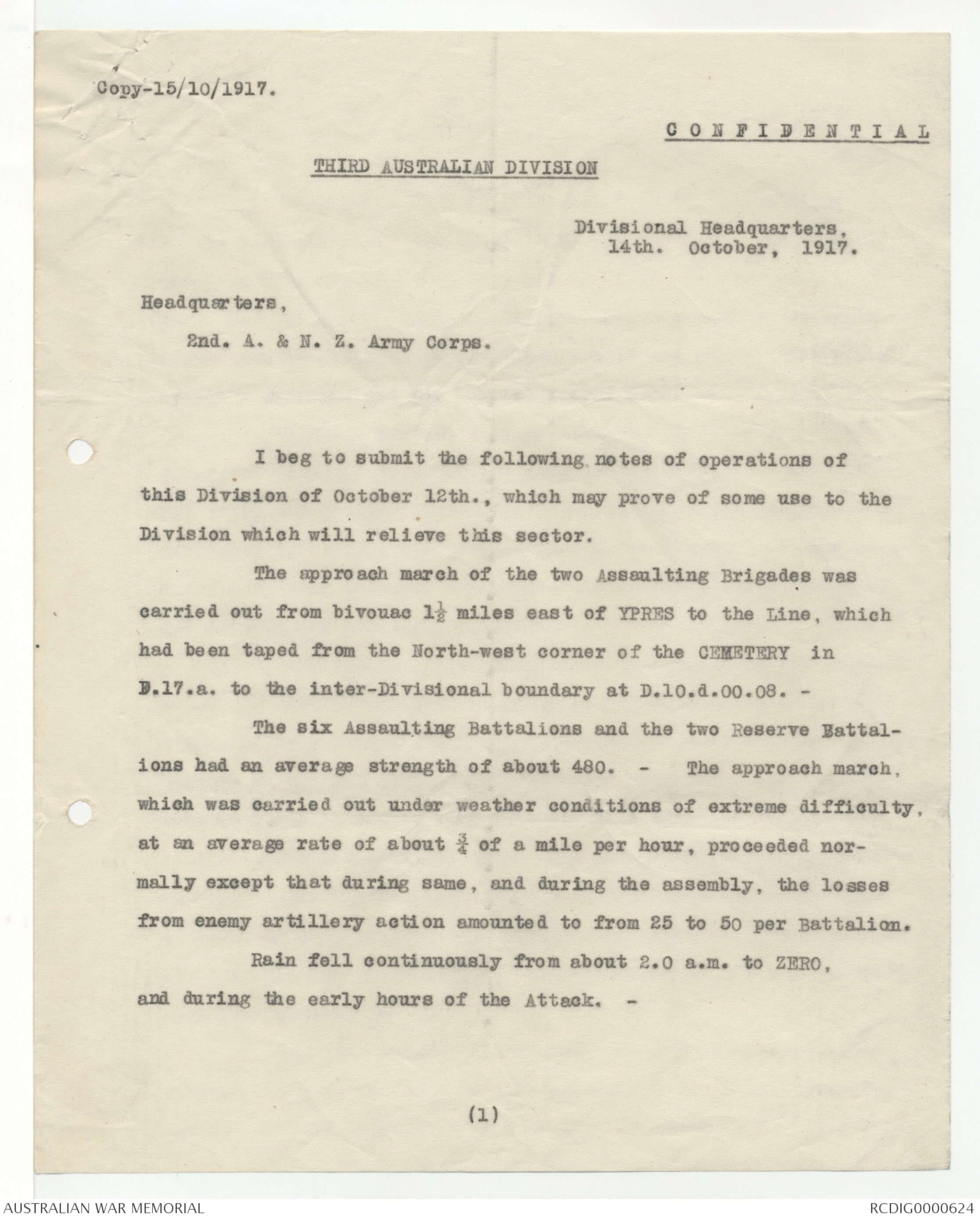
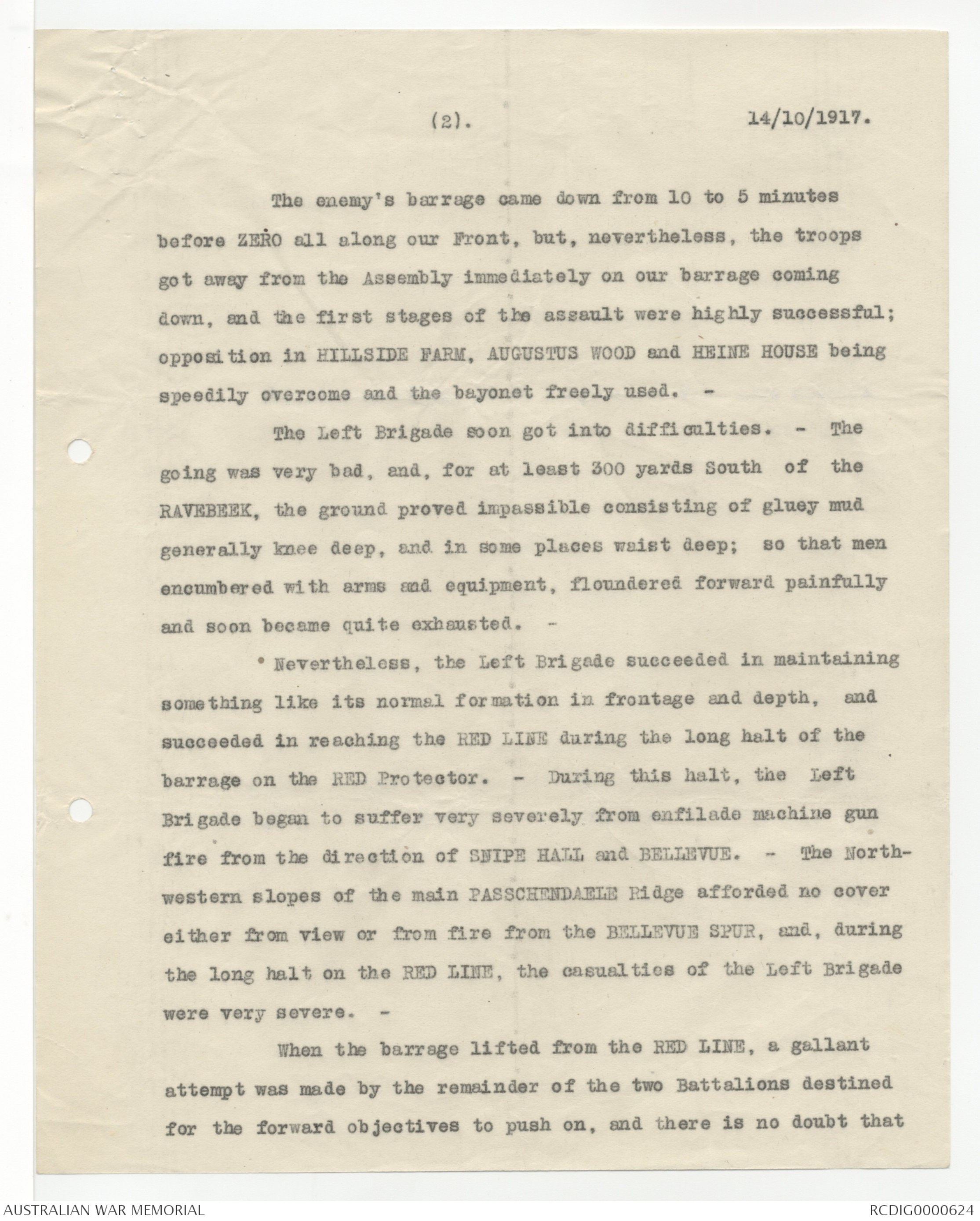
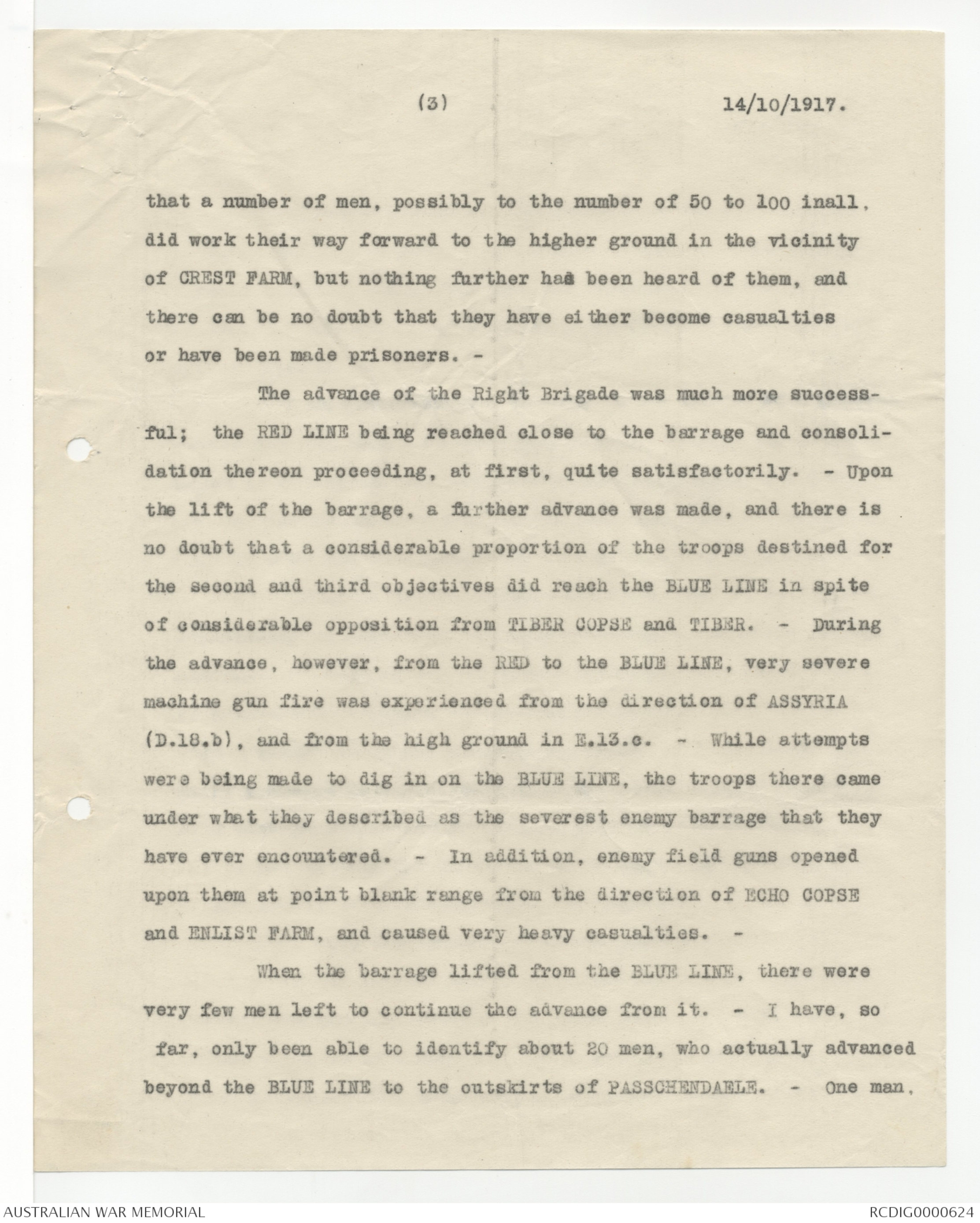
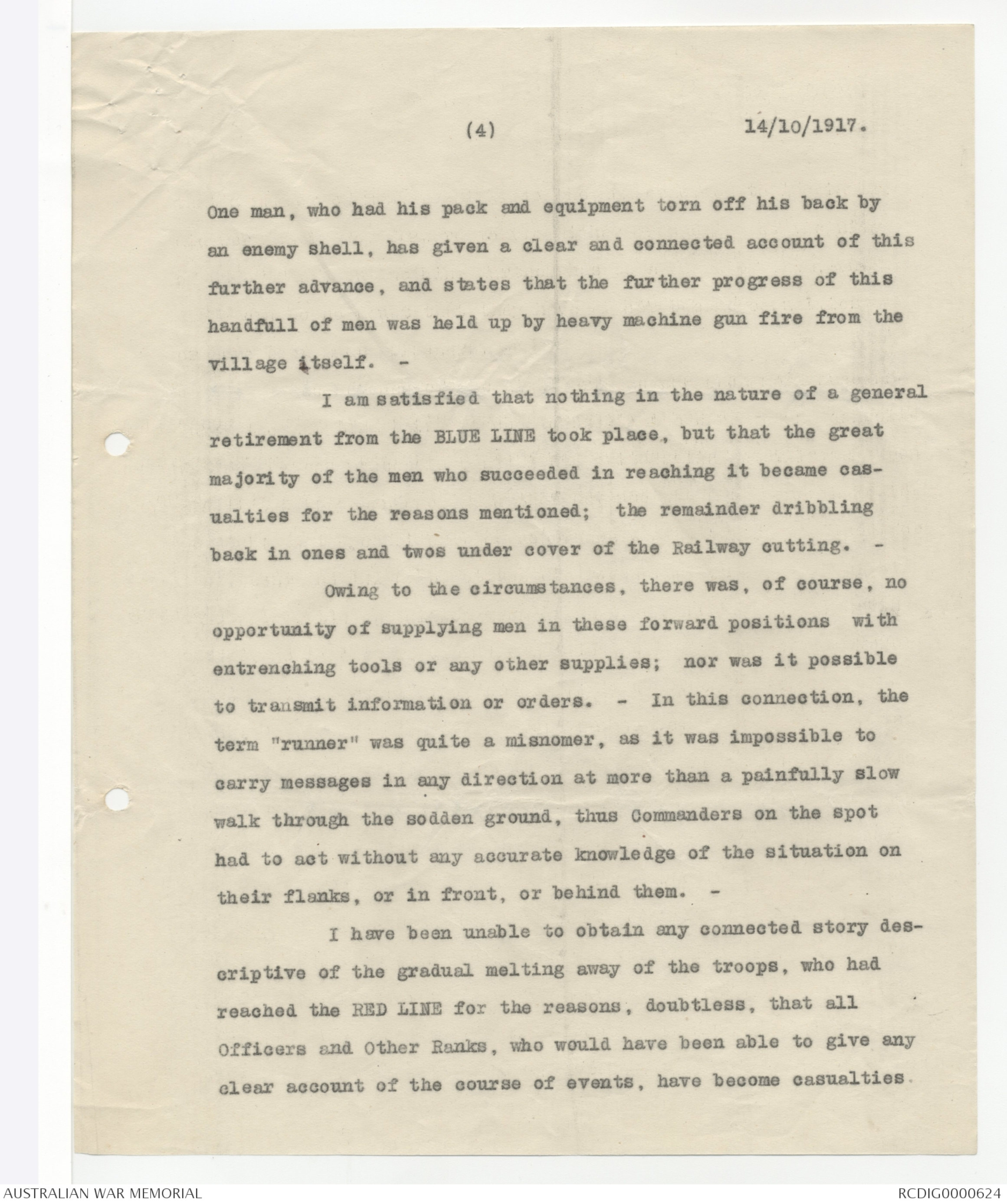
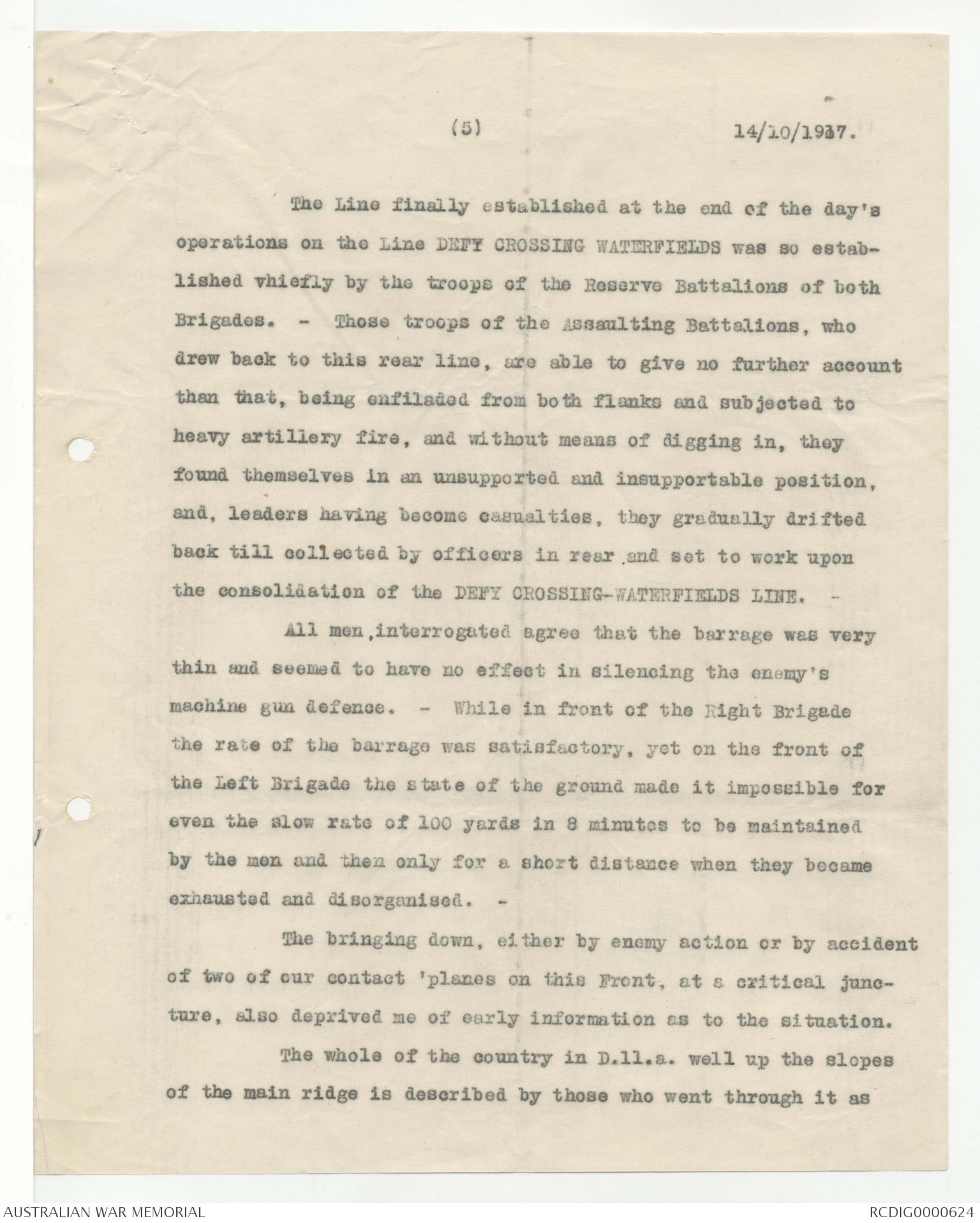
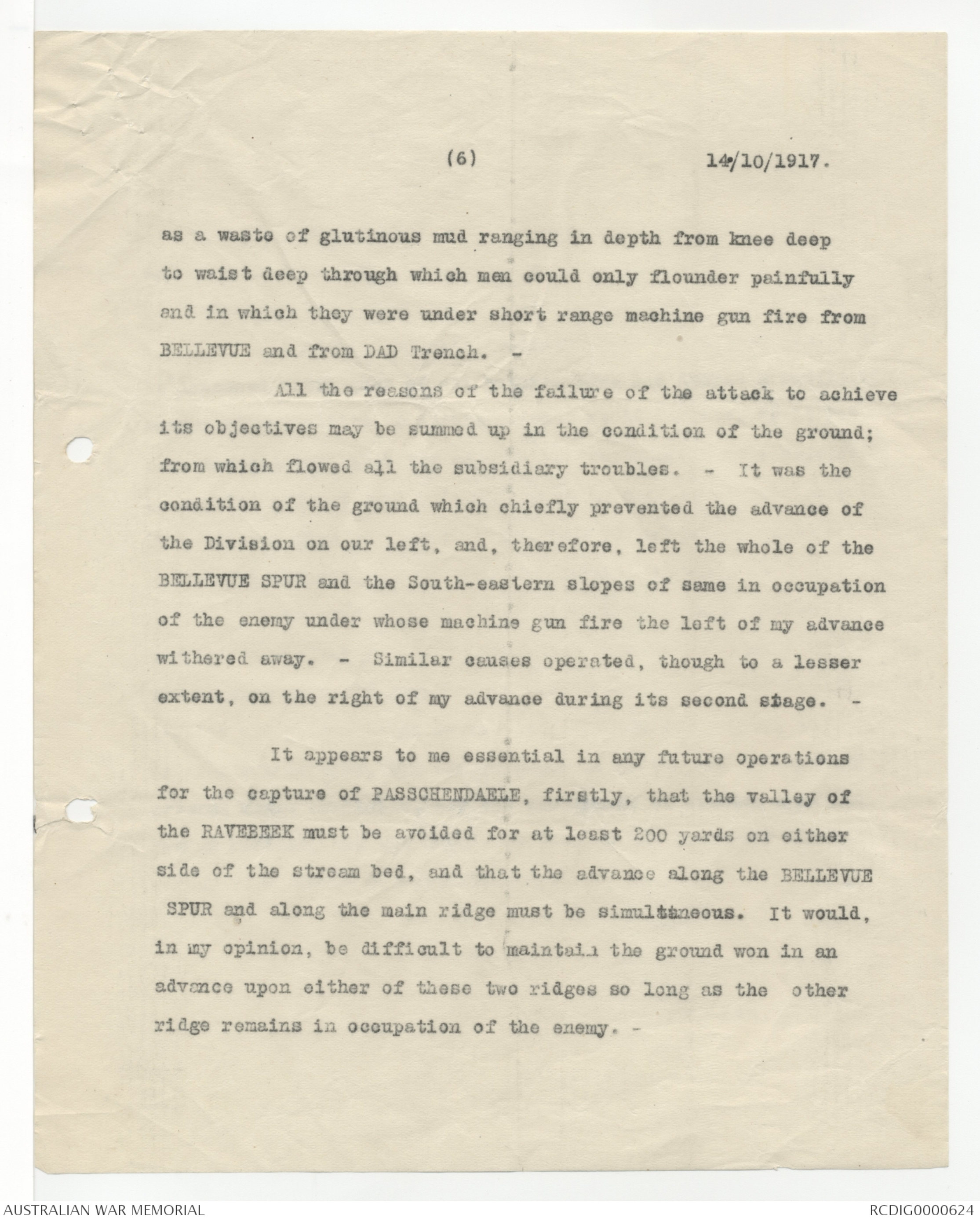
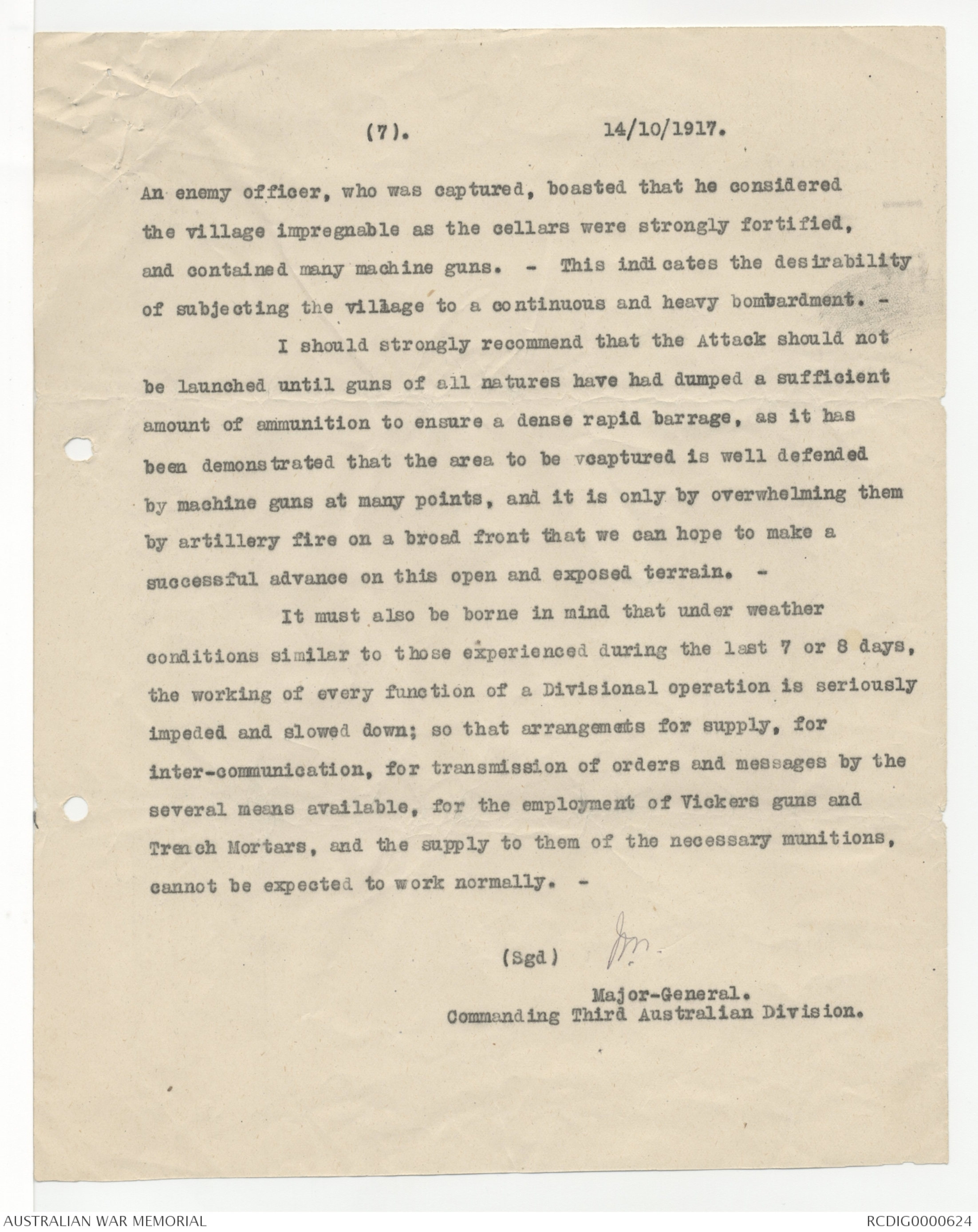
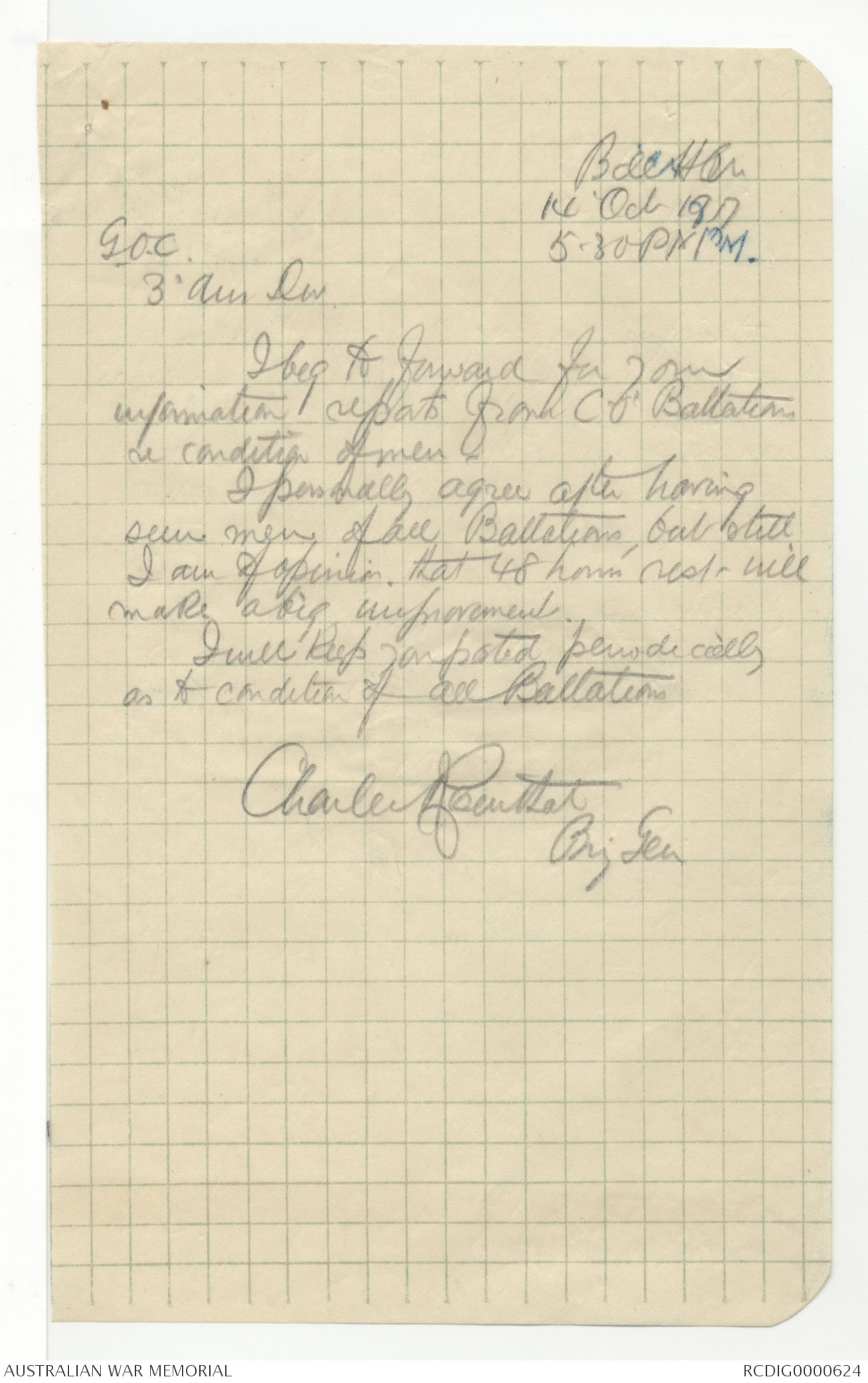
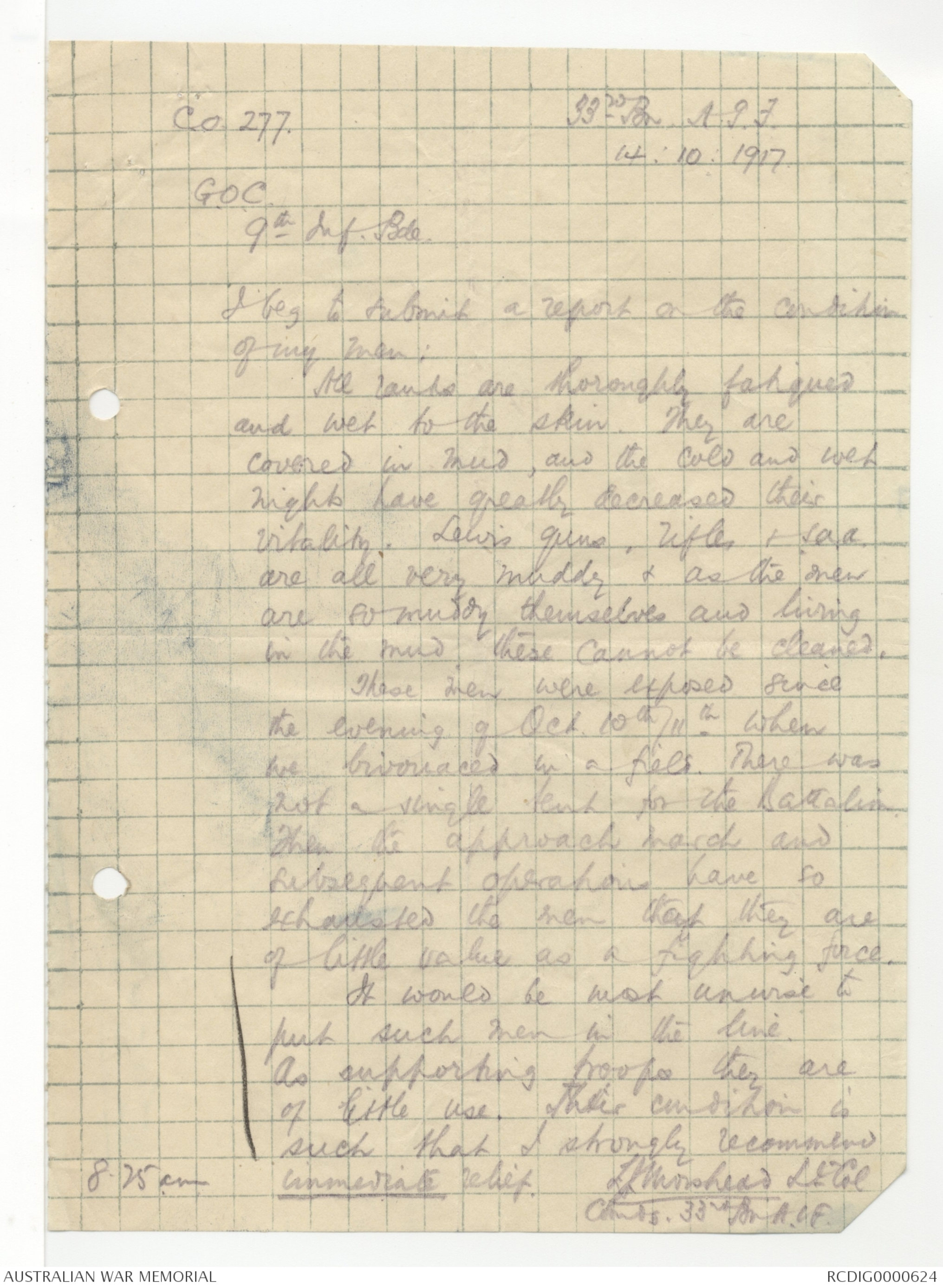
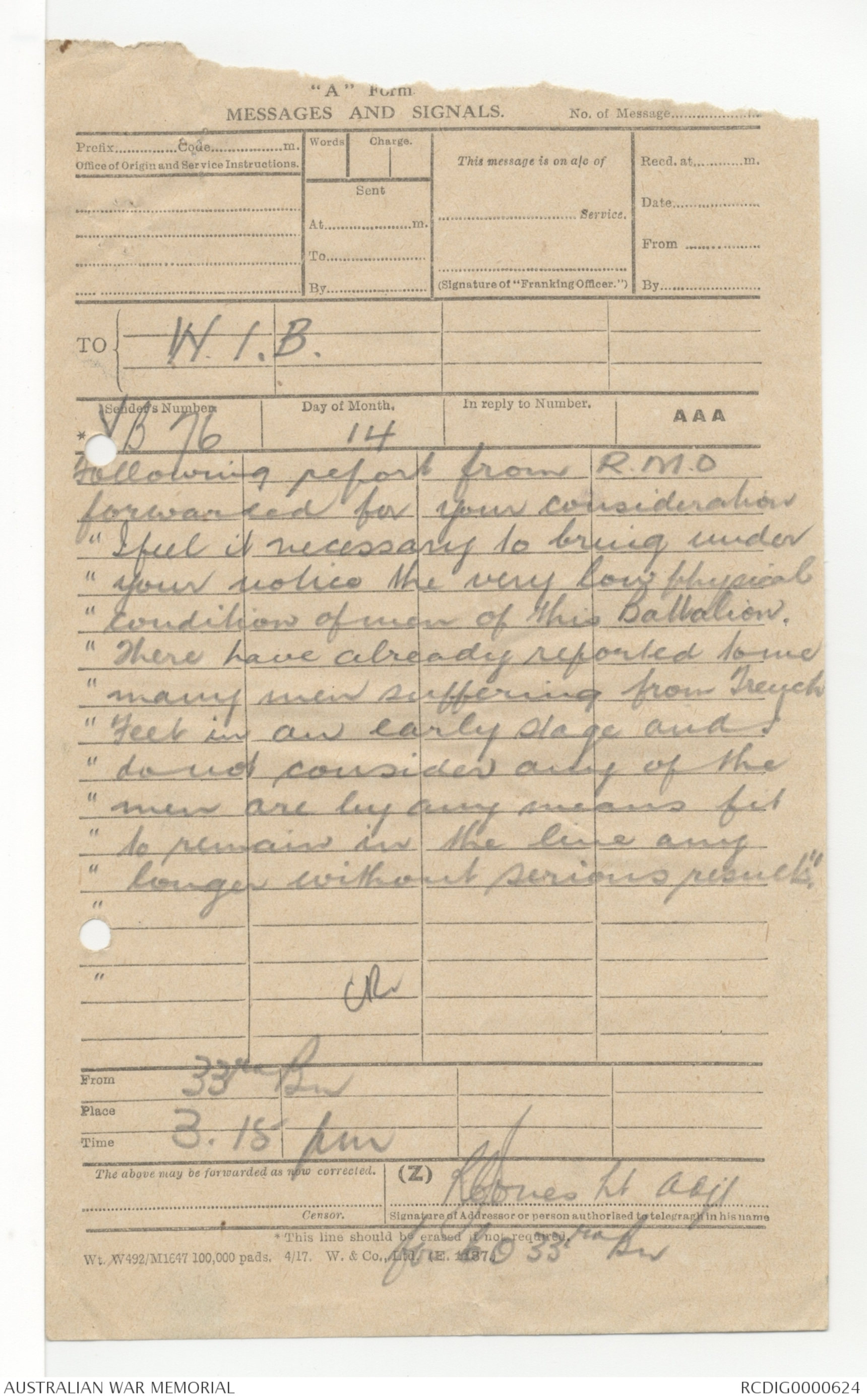
Copy-19/10/1917.
CONFIDENTIAL
THIRD AUSTRALIAN DIVISION
Divisional Headquarters,
14th. October, 1917.
Headquarters,
2nd. A. & N. Z. Army Corps.
I beg to submit the following notes of operations of
this Division of October 12th., which may prove of some use to the
Division which will relieve this sector.
The approach march of the two Assaulting Brigades was
carried out from bivouac 1 1/2 miles east of YPRES to the Line, which
had been taped from the North-west corner of the CEMETERY in
D.17.a. to the inter-Divisional boundary at D.10.d.00.08.-
The six Assaulting Battalions and the two Reserve Battalions
had an average strength of about 480. - The approach march,
which was carried out under weather conditions of extreme difficulty,
at an average rate of about 3/4 of a mile per hour, proceeded normally
except that during same, and during the assembly, the losses
from enemy artillery action amounted to from 25 to 50 per Battalion.
Rain fell continuously from about 2.0 a.m. to ZERO,
and during the early hours of the Attack.-
(1)
14/10/1917.
(2).
The enemy's barrage came down from 10 to 5 minutes
before ZER0 all along our Front, but, nevertheless, the troops
got away from the Assembly immediately on our barrage coming
down, and the first stages of the assault were highly successful;
opposition in HILLSIDE FARM. AUGUSTUS WOOD and HEINE HOUSE being
speedily overcome and the bayonet freely used.
The Left Brigade soon got into difficulties. - The
going was very bad, and, for at least 300 yards South of the
RAVEBEEK, the ground proved impassible consisting of gluey mud
generally knee deep, and in some places waist deep; so that men
encumbered with arms and equipment, floundered forward painfully
and soon became quite exhausted.
Nevertheless, the Left Brigade succeeded in maintaining
something like its normal formation in frontage and depth, and
succeded in reaching the RED LINE during the long halt of the
barrage on the RED Protector. - During this halt, the Left
Brigade began to suffer very severely from enfilade machine gun
fire from the direction of SNIPE HALL and BELLEVUE. - The North-
western slopes of the main PASSCHENDAELE Ridge afforded no cover
either from view or from fire from the BELLEVUE SPUR, and, during
the long halt on the RED LINE, the casualties of the Left Brigade
were very severe.
When the barrage lifted from the RED LINE, a gallant
attempt was made by the remainder of the two Battalions destined
for the forward objectives to push on, and there is no doubt that
(3)
14/10/1917.
that a number of men, possibly to the number of 50 to 100 inall,
did work their way forward to the higher ground in the vicinity
of CREST FARM, but nothing further has been heard of them, and
there can be no doubt that they have either become casualties
or have been made prisoners.-
The advance of the Right Brigade was much more success-
ful; the RED LINE being reached close to the barrage and consoli-
dation thereon proceeding, at first, quite satisfactorily. - Upon
the lift of the barrage, a further advance was made, and there is
no doubt that a considerable proportion of the troops destined for
the second and third objectives did reach the BLUE LINE in spite
of considerable opposition from TIBER COPSE and TIBER. - During
the advance, however, from the RED to the BLUE LINE, very severe
machine gun fire was experienced from the direction of ASSYRIA
(D.18.b), and from the high ground in E.13.c. - While attempts
were being made to dig in on the BLUE LINE, the troops there came
under what they described as the severest enemy barrage that they
have ever encountered. - In addition, enemy field guns opened
upon them at point blank range from the direction of ECHO COPSE
and ENLIST FARM, and caused very heavy casualties.
When the barrage lifted from the BLUE LINE, there were
very few men left to continue the advance from it. - I have, so
far, only been able to identify about 20 men, who actually advanced
beyond the BLUE LINE to the outskirts of PASSCHENDAELE. - One man,
14/10/1917.
(4)
One man, who had his pack and equipment torn off his back by
an enemy shell, has given a clear and connected account of this
further advance, and states that the further progress of this
handfull of men was held up by heavy machine gun fire from the
village itself.
I amsatisfied that nothing in the nature of a general
retirement from the BLUE LIME took place, but that the great
majority of the men who succeeded in reaching it became cas¬
ualties for the reasons mentioned; the remainder dribbling
back in ones and twos under cover of the Railway cutting.
Owing to the circumstances, there was, of course, no
opportunity of supplying men in these forward positions with
entrenching tools or any other supplies; nor was it possible
to transmit information or orders. - In this connection, the
term "runner" was quite a misnomer, as it was impossible to
carry messages in any direction at more than a painfully slow
walk through the sodden ground, thus Commanders on the spot
had to act without any accurate knowledge of the situation on
their flanks, or in front, or behind them.
I have been unable to obtain any connected story des-
criptive of the gradual melting away of the troops, who had
reached the RED LINE for the reasons, doubtless, that all
Officers and Other Ranks, who would have been able to give any
clear account of the course of events, have become casualties.
(5)
14/10/1927.
The Line finally established at the end of the day's
operations on the Line DEFY CROSSING WATERFIELDS was so estab-
lished vhiefly by the troops of the Reserve Battalions of both
Brigades. - Those troops of the Assaulting Battalions, who
drew back to this rear line, are able to give no further account
than that, being enfiladed from both flanks and subjected to
heavy artillery fire, and without means of digging in, they
found themselves in an unsupported and insupportable position,
and, leaders having become casualties, they gradually drifted
back till collected by officers in rear and set to work upon
the consolidation of the DEFY CROSSING-WATERFIELDS LINE. -
All men,interrogated agree that the barrage was very
thin and seemed to havo no effect in silencing the enemy's
machine gun defence. - While in front of the Right Brigade
the rate of the barrage was satisfactory, yet on the front of
the Left Brigade the state of the ground made it impossible for
even the slow rate of 100 yards in 8 minutes to be maintained
by the men and then only for a short distance when they became
exhausted and disorganised.
The bringing down, either by enemy action or by accident
of two of our contact 'planes on this Front, at a critical junc¬
ture, also deprived me of early information as to the situation.
The whole of the country in D.l1.a. well up the slopes
of the main ridge is described by those who went through it as
(6)
14/10/1917.
as a waste of glutinous mud ranging in depth from knee deep
to waist deep through which men could only flounder painfully
and in which they were under short range machine gun fire from
BELLEVUE and from DAD Trench.
All the reasons of the failure of the attack to achieve
its objectives may be summed up in the condition of the ground;
from which flowed all the subsidiary troubles. - It was the
condition of the ground which chiefly prevented the advance of
the Division on our left, and, therefore, left the whole of the
BELLEVUE SPUR and the South-eastern slopes of same in occupation
of the enemy under whose machine gun fire the left of my advance
withered away. - Similar causes operated, though to a lesser
extent, on the right of my advance during its second stage.
It appears to me essential in any future operations
for the capture of PASSCHENDAELE, firstly, that the valley of
the RAVEBEEK must be avoided for at least 200 yards on either
side of the stream bed, and that the advance along the BELLEVUE
SPUR and along the main ridge must be simultaneous. It would,
in my opinion, be difficult to maintain the ground won in an
advance upon either of these two ridges so long as the other
ridge remains in occupation of the enemy. -
(7).
14/10/1917.
An enemy officer, who was captured, boasted that he considered
the village impregnable as the cellars were strongly fortified,
and contained many machine guns. - This indicates the desirability
of subjecting the village to a continuous and heavy bombardment. -
I should strongly recommend that the Attack should not
be launched until guns of all natures have had dumped a sufficient
amount of ammunition to ensure a dense rapid barrage, as it has
been demonstrated that the area to be vcaptured is well defended
by machine guns at many points, and it is only by overwhelming them
by artillery fire on a broad front that we can hope to make a
successful advance on this open and exposed terrain. -
It must also be borne in mind that under weather
conditions similar to those experienced during the last 7 or 8 days,
the working of every function of a Divisional operation is seriously
impeded and slowed down; so that arrangements for supply, for
inter-communication, for transmission of orders and messages by the
several means available, for the employment of Vickers guns and
Trench Mortars, and the supply to them of the necessary munitions,
cannot be expected to work normally. -
(Sgd) J.M.
Major-General.
Commanding Third Australian Division.
Bde H Qr
14 Oct 1917
5.30 P.M.
G.O.C.
3 Aus Div
I beg to forward for your
information reports from C O Battalion
re condition of men.
I personally agree after having
seen men of all Battalions, but still
I am of opinion that 48 hours rest will
make a big improvement.
I will keep you posted periodically
as to condition of all Battalions.
Charles Rosenthal
Brig. Gen
C.O.277.
33rd Bn. A.I.F.
14.10.1917.
G.O.C.
9th Inf. Bde.
I beg to submit a report on the condition
of my men.
All ranks are thoroughly fatigued
and wet to the skin. They are
covered in mud, and the cold and wet
nights have greatly decreased their
vitality. Lewis guns, rifles & S.A.A.
are all very muddy & as the men
are so muddy themselves and living
in the mud, these cannot be cleaned.
These men were exposed since
the evening of Oct. 10th/11th when
we bivouaced by a field. There was
not a single tent for the Battalion.
Then the approach march and
subsequent operations have so
exhausted the men that they are
of little value as a fighting force.
It would be most unwise to
put such men in the line.
As supporting troops they are
of little use. Their condition is
such that I strongly recommend
[*8.25 a.m*] immediate relief.
L L Morshead Lt Col
Commd 33rd Bn A.I.F.
TO} W. I. B.
Senders Numbers
VB76
Day of Month
14
Following report from R. M. O.
forwarded for your consideration
" I feel it necessary to bring under
" your notice the very low physical
" condition of men of the Battalion.
" There have already reported to me
" many men suffering from Trench
" Feet in an early stage and I
" do not consider any of the
" men are by any means fit
" to remain in the line any
" longer without serious results.
"
"
CR
From 33 Bn
Time 3.15 pm
(Z) R Groves Lt Adjt
for C O 33rd Bn
 Sam scott
Sam scottThis transcription item is now locked to you for editing. To release the lock either Save your changes or Cancel.
This lock will be automatically released after 60 minutes of inactivity.